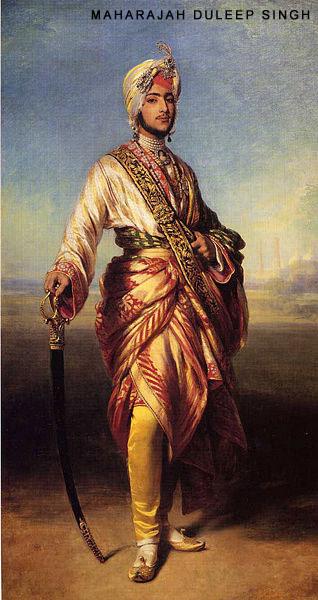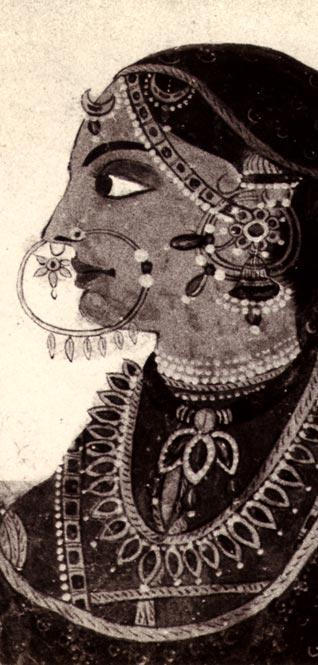
Above: detail from oil painting of Jind Kaur by George Richmond (1809-96). Image below, 2nd from bottom: Jind Kaur's mural in Raja Sansi near Amritsar, 1975. Photo, courtesy: Amarjit Singh Chandan Collection.



Film/Stage
Maharani Jind Kaur: Rebel Queen
by HARPREET KAUR GREWAL
A Sikh woman wearing a crinoline over her traditional clothes, and emeralds and pearls under her bonnet, walks in Kensington Gardens in 1861. She is the last Sikh queen of Lahore, the capital of the Punjab empire, and her name is Jindan Kaur. She died two years later, in 1863, and was buried in west London.
Maharani Jindan Kaur's life - much of which was spent raging against the British empire for cheating her out of the Punjab, then a vast country stretching from the Khyber Pass to Kashmir - is the subject of a documentary film called Rebel Queen, which is set to be released shortly.
Her revolt began when her husband, the last Maharaja of the Punjab, died of a stroke in 1839 and the British tried to wrest the kingdom from the heir to the throne, her infant son, Duleep Singh. During her rule as regent, Jindan defended against two disastrous wars concocted by the British that ultimately led to the annexation of the Punjab. She may have made huge strategic errors due to her military inexperience and young age (she was in her early 20s), but Jindan was a fierce ruler.
British historian Peter Singh Bance describes her as a "very gutsy woman". "She stood her ground against the British . . . she actively took charge of the Punjab."
Professor Nikky-Guninder Kaur Singh of Colby College, Maine, U.S.A., says: "She was remarkable in how she discarded sati and purdah, dominant at the time, and led the courts, had meetings with chief ministers and the armies. All of them were taking her counsel."
Christy Campbell, author of The Maharajah's Box, a book about the Maharani's son, Duleep - the last Emperor of Punjab - says Jindan was "one of the most remarkable characters of 19th-century history, let alone Indian or Sikh history". This is despite the fact that much of what is known about her is "through the words of the British, who regarded her as a threat to their power in India and therefore did their best to make her reputation as bad as possible".
The Maharani was described as "a serious obstacle" to British rule in India. They launched a smear campaign to discredit her, painting her as the "Messalina of the Punjab", a seductress too rebellious to be controlled. She refused to co-operate and the British saw that her influence on Duleep could lead to an uprising among the Sikhs. They decided to separate mother and son.
Nine-year-old Duleep was later taken to England after, in his tender age, he had been converted to Christianity. Thereafter, he lived the life of a typical English gentleman, with Queen Victoria and the Prince of Wales amongst his friends.
The Maharani Jindan, however, was dragged from the court of Lahore by her hair and thrown into the fortress of Sheikhupura and then Chunar Fort in Uttar Pradesh.
After being imprisoned, she disguised herself as a servant and escaped the fort. She travelled through 800 miles of forest to reach sanctuary in Nepal, where she wrote a letter boasting to the British that she had escaped by "magic". She never regained the kingdom for her son. But they were reunited years later, which prompted the Maharajah to convert back to Sikhism, undoing the work of the British to brainwash him.
Her story encouraged American entrepreneur Bicky Singh to fund the production of Rebel Queen with around $25,000 (£15,500). Director Michael Mohinder Singh, a California-based film-maker, says: "There's great drama and tragedy in her story. She was a heroic figure and was well-documented by the British. There are not a lot of documented women in Sikh history. [At the same time], her son [socialized] with Queen Victoria, which makes the story more relevant to the casual viewer."
According to Michael Singh, Jindan is a symbol of indignation and injustice, but also of the failure of the Sikhs to retain their kingdom. "She has an iconic status," he says. "She was the last one to stand up to the British."
When I saw the film, I was struck by how little I knew about my heritage. Growing up in a Punjabi Sikh household in east London, I looked up to my hard-working and honest parents, but when it came to who I wanted to be, I built a composite from American girl detective Nancy Drew, TV FBI agent Dana Scully and Bruce Springsteen. All of these individuals pushed against barriers into a world of possibility, something I rarely found in my culture.
But where were women like Jindan Kaur? Jindan was complex, cocky, clever, imperfect and tough, and she connected me to my ancestral past, something Nancy, Dana and Bruce could not. After watching Rebel Queen, I felt like a link to my past that had lain neglected had been rekindled.
Numerous South Asian female artists have documented the struggles of British Asian identity, including Gurinder Kaur Chadha, Meera Syal and Shazia Mirza. Struggles of displacement need to be documented, but there are not enough stories like Maharani Jindan's, about what had happened before my family had to grapple with being Asian in a white society. Was I supposed to start from my parents' immigration to England in the 1970s? Couldn't the example of Maharani Jindan give me the inspiration to make sense of my present day-to-day life?
In England, there is a prevalence of perceiving South Asian women in the context of "honour" killings, forced marriages, domestic violence and foeticide - all serious issues that need to continue to be fought against. We also have the Asian Women of Achievement awards, but those women do not always permeate the media, art or history books that young girls may be absorbing. In terms of what that leaves young British Punjabi Sikh or South Asian girls as role models, it is not exactly aspirational.
Artists Rabindra and Amrit Singh say: "We definitely need to . . . counter the negative stereotyping that so many of us grew up with . . . [This will come] from a better knowledge and pride in who we are, which involves looking to the exemplary, too often hidden figures in our history."
There are other inspirational heroines about whom there is little research. Mai Bhago was a devout warrior saint in the army of Sikhism's 10th Teacher, Guru Gobind Singh, in the 1700s, who led men into battle. There is also Bibi Dalair Kaur who rallied 100 women Sikh soldiers to fight the Mughals in the 17th century.
[Courtesy: The Guardian. Edited for sikhchic.com]
January 2, 2011
Conversation about this article
1: Raminder (India), December 31, 2010, 9:17 AM.
Amazing story of Jindan Kaur. She is our legacy and will remain a role model for the coming generations. Truly shows how our Kaurs have ruled the roost.
2: Navdeep (Fresno, California, U.S.A.), January 03, 2011, 10:36 AM.
Where can this film be seen/ purchased? Wish there was a central online repository for all these efforts by Sikh film makers ...
3: Harjinder (United Kingdom), January 03, 2011, 4:58 PM.
A must read and something worth sending to others.
4: Maneck N. Bhujwala (Huntington Beach, California, U.S.A.), January 05, 2011, 3:59 PM.
It was inspiring to learn about this brave queen of the Sikhs. Like the Zoroastrian Persian Empire that also had queens and women in power, and their Parsi descendants in India, the Sikhs can particularly be proud of their equal treatment of women.
5: Ajit Virdi (Pune, India), January 06, 2011, 9:24 PM.
The story of Maharani Jindan is inspiring and amazing, but tragic too - would love to see the movie and to know more about the gutsy queen who chose to fight the treacherous British despite the odds.
6: R. Singh (Canada), January 07, 2011, 11:18 AM.
We could add Maharani Sahib Kaur of Patiala to the list. She stood up to the Marathas, in their quest to take over Sikhs states, saving not just Patiala but Jind and others as well.
7: Jiwan Jot Kaur Khalsa (New York, USA), June 16, 2011, 11:17 AM.
Where can I find this movie to see or buy?
8: Komal Sandhu (London, United Kingdom), April 06, 2012, 4:25 PM.
I would like to watch this movie. There is not enough out there for us to know our heritage and rich history. Please tell me how to order this movie.
9: D.M. (USA), October 28, 2012, 5:16 PM.
Apparently Brits did the same to the Hawaiian people, and Americans, following suit, further collaborated with the corporo-parasitic invasion, setting off a chain of events that led to WWII. Basically, it's all very criminally invasive, but as long as the world continues to tolerate patriarchal egomania, and the suppression of women and knowledge about their struggles to preserve their cultures, heritage and legacies is condoned, the lies and frauds will continue to fester like a cancer upon all people. May long live truth and memory, for some day wrongs may be set right.
10: Jindan Kaur (San Miguel de Allende, Mexico), April 15, 2013, 6:53 PM.
Where can one purchase the DVD of 'Rebel Queen'?


